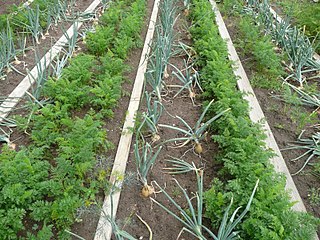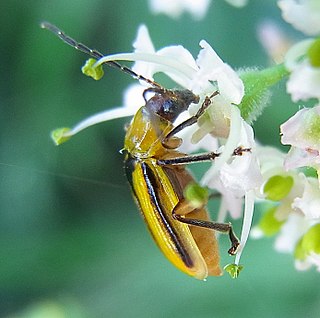
Companion planting in gardening and agriculture is the planting of different crops in proximity for any of a number of different reasons, including weed suppression, pest control, pollination, providing habitat for beneficial insects, maximizing use of space, and to otherwise increase crop productivity. Companion planting is a form of polyculture.

The Western corn rootworm, Diabrotica virgifera virgifera, is one of the most devastating corn rootworm species in North America, especially in the midwestern corn-growing areas such as Iowa. A related species, the Northern corn rootworm, D. barberi, co-inhabits in much of the range and is fairly similar in biology.

Plant defense against herbivory or host-plant resistance (HPR) is a range of adaptations evolved by plants which improve their survival and reproduction by reducing the impact of herbivores. Plants can sense being touched, and they can use several strategies to defend against damage caused by herbivores. Many plants produce secondary metabolites, known as allelochemicals, that influence the behavior, growth, or survival of herbivores. These chemical defenses can act as repellents or toxins to herbivores or reduce plant digestibility. Another defensive strategy of plants is changing their attractiveness. To prevent overconsumption by large herbivores, plants alter their appearance by changing their size or quality, reducing the rate at which they are consumed.

Maize dwarf mosaic virus (MDMV) is a pathogenic plant virus of the family Potyviridae. Depending on the corn plant’s growth stage, the virus can have severe implications to the corn plant’s development which can also result in economic consequences to the producer of the crop.
The enzyme indole-3-glycerol-phosphate lyase catalyzes the chemical reaction

Maize ; Zea mays subsp. mays, also known as corn in North American and Australian English, is a cereal grain first domesticated by indigenous peoples in southern Mexico about 10,000 years ago. The leafy stalk of the plant gives rise to inflorescences which produce pollen and separate ovuliferous inflorescences called ears that when fertilized yield kernels or seeds, which are botanical fruits. The term maize is preferred in formal, scientific, and international usage as the common name because it refers specifically to this one grain whereas corn refers to any principal cereal crop cultivated in a country. For example, in North America and Australia corn is often used for maize, but in England and Wales it can refer to wheat or barley, and in Scotland and Ireland to oats.

Coccinella transversalis, commonly known as the transverse ladybird or transverse lady beetle is a species of ladybird beetle found from India across southern and southeastern Asia to Malesia and Australia. It is not to be confused with Coccinella transversoguttata, a widespread species in Europe and North America also known as the transverse ladybird. The alternative vernacular of small transverse ladybird may be used for C. transversalis in instances where these two species are discussed together.
Green leaf volatiles (GLV) are organic compounds released by plants. Some of these chemicals function as signaling compounds between either plants of the same species, of other species, or even different lifeforms like insects.

Rhopalosiphum maidis, common names corn leaf aphid and corn aphid, is an insect, and a pest of maize and other crops. It has a nearly worldwide distribution and is typically found in agricultural fields, grasslands, and forest-grassland zones. Among aphids that feed on maize, it is the most commonly encountered and most economically damaging, particularly in tropical and warmer temperate areas. In addition to maize, R. maidis damages rice, sorghum, and other cultivated and wild monocots.
3-hydroxyindolin-2-one monooxygenase (EC 1.14.13.139, BX4 (gene), CYP71C1 (gene)) is an enzyme with systematic name 3-hydroxyindolin-2-one,NAD(P)H:oxygen oxidoreductase (2-hydroxy-2H-1,4-benzoxazin-3(4H)-one-forming). This enzyme catalyses the following chemical reaction
2-Hydroxy-1,4-benzoxazin-3-one monooxygenase (EC 1.14.13.140, BX5 (gene), CYP71C3 (gene)) is an enzyme with systematic name 2-hydroxy-2H-1,4-benzoxazin-3(4H)-one,NAD(P)H:oxygen oxidoreductase (N-hydroxylating). This enzyme catalyses the following chemical reaction
2,4-dihydroxy-1,4-benzoxazin-3-one-glucoside dioxygenase (EC 1.14.20.2, BX6 (gene), DIBOA-Glc dioxygenase) is an enzyme with systematic name (2R)-4-hydroxy-3-oxo-3,4-dihydro-2H-1,4-benzoxazin-2-yl beta-D-glucopyranoside:oxygen oxidoreductase (7-hydroxylating). This enzyme catalyses the following chemical reaction
2,4,7-trihydroxy-1,4-benzoxazin-3-one-glucoside 7-O-methyltransferase is an enzyme with systematic name S-adenosyl-L-methionine:(2R)-4,7-dihydroxy-3-oxo-3,4-dihydro-2H-1,4-benzoxazin-2-yl β-D-glucopyranoside 7-O-methyltransferase. This enzyme catalyses the following chemical reaction
2,4-Dihydroxy-7-methoxy-2H-1,4-benzoxazin-3(4H)-one 2-D-glucosyltransferase is an enzyme with systematic name UDP-alpha-D-glucose:2,4-dihydroxy-7-methoxy-2H-1,4-benzoxazin-3(4H)-one 2-beta-D-glucosyltransferase. This enzyme catalyses the following chemical reaction
4-Hydroxy-7-methoxy-3-oxo-3,4-dihydro-2H-1,4-benzoxazin-2-yl glucoside beta-D-glucosidase (EC 3.2.1.182, DIMBOAGlc hydrolase, DIMBOA glucosidase) is an enzyme with systematic name (2R)-4-hydroxy-7-methoxy-3-oxo-3,4-dihydro-2H-1,4-benzoxazin-2-yl beta-D-glucopyranoside beta-D-glucosidase. This enzyme catalyses the following chemical reaction

The biosynthesis of benzoxazinone, a cyclic hydroxamate and a natural insecticide, has been well-characterized in maize and related grass species. In maize, genes in the pathway are named using the symbol bx. Maize Bx-genes are tightly linked, a feature that has been considered uncommon for plant genes of a biosynthetic pathways. Especially notable are genes encoding the different enzymatic functions BX1, BX2 and BX8 and which are found within about 50 kilobases. Results from wheat and rye indicate that the cluster is an ancient feature. In wheat the cluster is split into two parts. The wheat genes Bx1 and Bx2 are located in close proximity on chromosome 4 and wheat Bx3, Bx4 and Bx5 map to the short arm of chromosome 5; an additional Bx3 copy was detected on the long arm of chromosome 5B. Recently, additional biosynthetic clusters have been detected in other plants for other biosynthetic pathways and this organization might be common in plants.
Function Maize gene for first step in biosynthesis of benzoxazin, which aids in resistance to insect pests, pathogenic fungi and bacteria.

Tritrophic interactions in plant defense against herbivory describe the ecological impacts of three trophic levels on each other: the plant, the herbivore, and its natural enemies. They may also be called multitrophic interactions when further trophic levels, such as soil microbes, endophytes, or hyperparasitoids are considered. Tritrophic interactions join pollination and seed dispersal as vital biological functions which plants perform via cooperation with animals.

Georg Jander is an American plant biologist at the Boyce Thompson Institute in Ithaca, New York. He has an adjunct appointment in the Plant Biology Section of the School of Integrative Plant Sciences at Cornell University. Jander is known for his molecular research identifying genes for biochemical compounds of ecological and agricultural importance, particularly those plant traits involved in resistance to insect pests.











